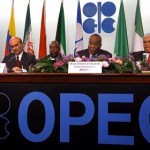According a recent World Oil.com report, U.S. oil major ConocoPhillips has halted talks about the development of a shale gas block in China. The same report also mentions that China has cut down its 2020 shale gas production target to a third of the original number. Both these developments indicate that OPEC’s refusal to cut oil production has finally achieved its goal of discouraging the development of potential oil & gas resources.
Earlier this year on 5 June, oil exporters’ group OPEC had refused to cut oil production in response to low oil prices. Popular opinion at the time was that:
- Saudi Arabia is producing more oil to regain market share
- OPEC is targeting existing U.S. shale oil producers
Both these views are wrong.
Market share doesn’t mean anything in the case of undifferentiated commodities bought in bulk by industrial consumers. Consumers (oil importers) can shift easily from one oil supplier to the other for a small price difference. India’s recent oil import bill illustrates this perfectly. While Saudi Arabia has been India’s top supplier in the past, in June 2015 Iraq became its biggest supplier, In May, Nigeria was the top supplier as it was selling cheap. We never hear of South Africa producing more gold or selling it cheap to preserve marketshare. Somehow, petroleum is this miraculous commodity where market share suddenly matters.
By keeping production high, OPEC is not targeting U.S. existing shale oil producers. In a production war, a country cannot compete against a company. A company can cut down its workforce and capital expenditure. A country cannot do so as easily—it needs to continue paying the salaries of government employees, armed forces, pensions and other social obligations. In the worst case, a company can declare bankruptcy, and be acquired at a discount – cutting down the debt and the cost structure of the oil/gas field for the new buyer. A country doesn’t quite have the same options therefore its only option is to prevent companies from making investments in future production
Saudi Arabia, and many of the other OPEC oil exporters, can sustain oil production for over a century at their current production rate. It is therefore logical to assume that these countries are not looking at oil prices just for the next three months, but at the oil market 10-20 years from now. By keeping production high, they can push down prices – which will drive away new investments in oil and gas production – and eventually keep future oil and gas production down in the long term.
This is what seems to be happening to shale gas in China. It is a continuation of a trend that has already started with global hydrocarbon majors such as ExxonMobil, BP, Shell, ConocoPhillips, Gazprom, among others, cutting down spending on exploration.
So what does this mean for India?
India is an oil importer today and will remain an oil importer ten years from now as well. Low prices in the short term are welcome, but what the Indian economy needs is low and predictable energy prices in the medium and long term as well. Therefore, the current environment offers an opportunity: oil and gas fields across the world, and the companies which own them, have lost value and can be bought cheap(because of low oil prices). Indian companies need to actively pursue this path and focus on acquiring oil fields and oil companies abroad in order to secure a stable and predictable supply of oil in the medium and long term as well.
Amit Bhandari is Fellow, Energy & Environment Studies, Gateway House
This blog was exclusively written for Gateway House: Indian Council on Global Relations. You can read more exclusive content here.
For interview requests with the author, or for permission to republish, please contact outreach@gatewayhouse.
© Copyright 2015 Gateway House: Indian Council on Global Relations. All rights reserved. Any unauthorized copying or reproduction is strictly prohibited.


